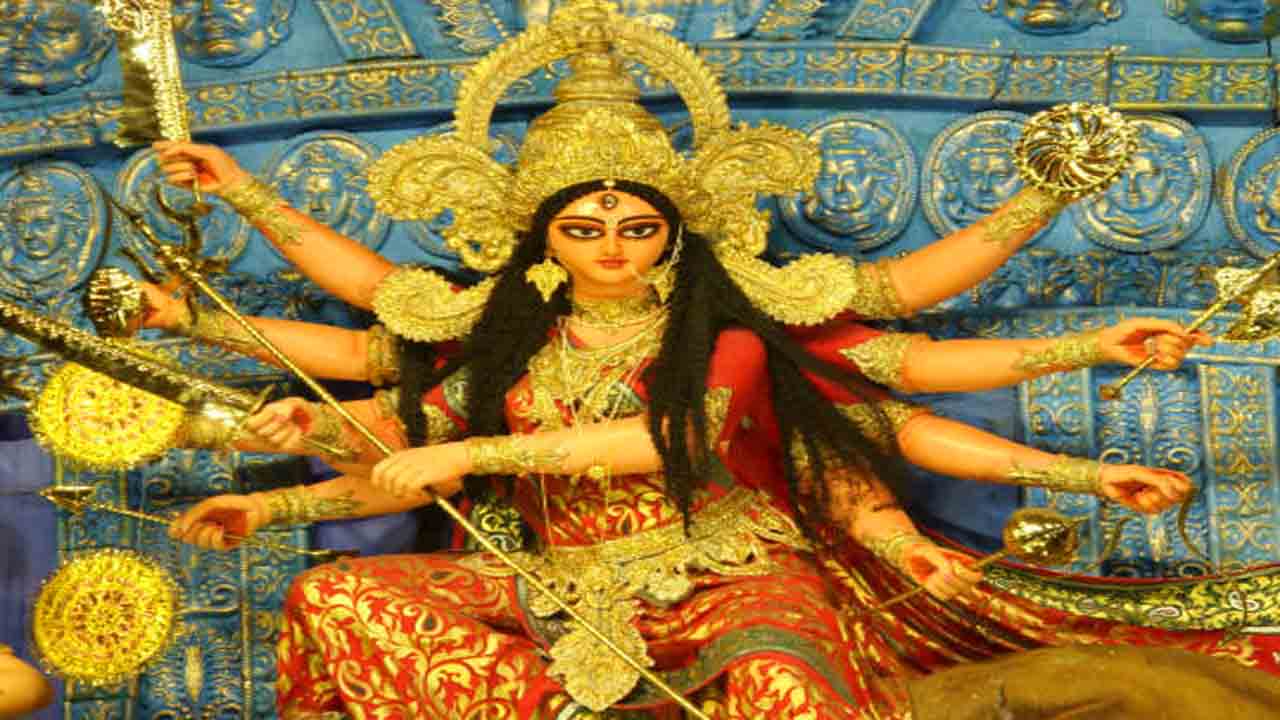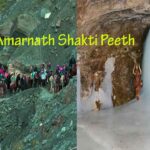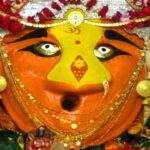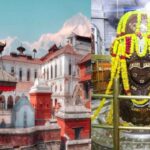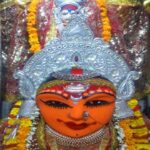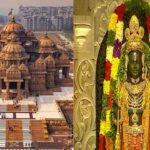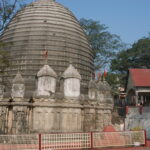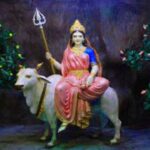13 Shakti Peeths in West Bengal are famous pilgrimage in India those are always over crowded by devotees most of the time in the year. Shakti Peeth means Sati Peeth where the parts of the body of Sati, (an incarnation of Goddess Durga), fallen down to the earth, (when Lord Vishnu cut her body by Sudarshan Chakra, at the Tandav phase of lard Shiva, carrying dead body of Sati), that place transformed in to a temple which called Shakti Peeth or Sati Peeth.
It is believed that 52 pieces of the body of Mata Sati transformed in 51 Shakti Peeths around India and neighboring country like Bangla Desh, Pakistan, Nepal, Assam and others. Among those 13 Shakti peeths in West Bengal are found in various parts of the state also.
13 Shakti Peeths In West Bengal
The maximum no. of Shakti Peeths found in West Bengal with numerous names and places. The significance of all temples are same but located in different places in West Bengal.
1. Kalighat Temple is famous among 13 Shakti Peeths In West Bengal
One of the most oldest and sacred Shakti Peeth, Kalighat most famous Shakti Peeth in West Bengal. Although according to legend the Kalighat Temple existed from the time of Chandragupta Maurya II, but present structure was built in the year 1809 and Goddess Shakti worshiped here as Mata Kalika since ages.
The idol of Goddess Kali worshipped here with three big eyes and long highlighted tongue as calm graceful look. Devotees offers prayers and Aarti at morning and evening daily but Saturday and Tuesday is specially crowded for more auspicious significance of blessings, it is believed.
Kalighat is one of the most sacred place of Shakti Peeth, where thousands of devotees visit from all over the country daily. It is believed that all wishes of devotees are granted and gifted by Mata Kalika, whoever pray with full devotion and belief. The Right Toe of Mata Sati has fallen here and formed the Kalighat Shakti Peeth Temple and Nakuleshwar Shiva formation.
2. Kankalitala Temple Is Auspicious Among 13 Shakti Peeths In West Bengal
The famous Shakti Peeth of Kankalitala is located near Kopai river in Bolepur, Birbhum among 13 Shakti Peeths In West Bengal. It is believed that Waist of Mata Sati has fallen here which made a deep kund on the surface of the earth near the temple. This Kund was filled with water and devotees collect the water as holy blessings of Goddess.
Kankalitala Shakti Peeth has no idol but a painting of Shakti has worshipped since ages and holy Kund is dedicated to the place where the body part of Sati has fallen. It is also believed that all wishes of devotees are fulfilled by Goddess Shakti for unconditional belief.
The goddess and Her divine partner Shambhu Baba or Ruru Bhairav, a Shiva Lingam also found in the Shiva Temple at the complex premises. Devotees here pray for seeking Salvation or Moksha, wealth and health. The famous festival in the Temple are Shivratri and Navratri.
3. Attahas Temple is Mystical Among 13 Shakti Peeths In West Bengal
Dedicated to Adi Shakti the Attahas Temple situated on the banks of the river Ishani, lies on the Labhpur to Ahmedpur Road which is a famous Shakti Peeth and the deity inside the temple is Maa Phullara and Bhairav Vishwesh is said to be guarding her.
The main idol of the goddess Sati is called Phullara and Lord Shiva is worshiped here as Vishvesha. It is believed that since Fullara means blooming, that consider there will be proper growth of everything from the soil. People offer items to god as prayers that grows well in soil, which considered as very auspicious among 13 Shakti Peeths in West Bengal.
The village of Attahas celebrates their annual Phullara Mela where the elders of the village tell stories about the history associated with the Temple. The festival of Navratri in Durga Puja is also celebrated with a lot of enthusiasm with numerous special pujas and rituals.
The lower lip of Mata Sati has fallen here and fifteen feet long stone idol of Mata Attahas symbolizes the lower lip of the goddess. A natural pond at the right adjacent to the temple complex, has a mythological story about it. According to legend Hanuman have collected 108 lotuses from this pond for worship of ‘Akal Bodhon’ of Sri Rama.
4. Bahula Shakti Peeth Is Heavenly Among 13 Shakti Peeths In West Bengal
Bahula Shakti Peeth is another manifestation of Adi Shakti, the female spiritual energy of the universe among 13 Shakti Peeths in West Bengal. This Temple is located on the banks of Ajay river at Ketugram.
The ‘left arm’ of Sati has fallen here and ‘Bahu’ in Sanskrit means ‘arm’, when ‘Bahula’, on the other hand, means ‘abundance’ which refers goddess Bahula brings prosperity in abundance manner.
It is believe that Bahula Shakti Peeth is so auspicious that Mata Bahula never left her devotees empty handed, who offers prayer to her with genuine belief in their hearts and instances of wonders often happened with many peoples here.
Mata Bahula accompanied by her sons Karthikey and Ganesha, along with the Bhairav Bhiruk and both are said to be manifestations of Mahadev and Mata Adi Shakti.
5. Bakreshwar Temple Is Majestic Among 13 Shakti Peeths In West Bengal
One of the most famous and powerful Shakti Peeth among 13 Shakti Peeths in West bengal is Bakreshwar Shakti Peeth. The idol of Mata Mahishmardini is so majestic and powerful to look which is truly touching.
The Bakreshwar Temple located on the bank of the Paaphra River, Birbhum, and 240 km from Kolkata. Renowned for Oriya style of architecture the Mahishmardini and the Vakranath temple is something different from others. The portion between eyebrows of Mata Sati has fallen here, which is said to be ‘mind’ of Goddess.
The idol of Devi Mahishmardini worshipped here as destroyer of Mahishasura, and is protected by the Bhairav Vakranath. The Paaphra River is known for get rid of Sins after dip in to the river. The famous sage Rishi Ashtabhakra is said to have got Nirvana after bathing in the Paaphra river.
Bakreshwar also famous for popular tourist destination and is known for it’s spectacular scenic beauty. The seven famous hot springs surrounding the region are Agni Kund, Brahma Kund, Surya Kund, Saubhagya Kund, Amrita Kund, Kheer Kund, Jibat Kund and Vairav Kund, and each of them associated with a ShivLinga.
6. Ratnavali or Anandamoyee Temple Is Glorious Among 13 Shakti Peeths In West Bengal
Ratnavali Shakti Peeth in Krishnanagar is commonly known as Anandamoyee Temple is famous among 13 Shakti Peeths in West Bengal. Located at the bank of the river Ratnakar, in Krishnanagar, Hooghly, an ancient Hindu religious place. Mata Ananadamoyee worshipped here as ‘Kumari’ with ‘Vairava’ Shiva.
It is believed that the right shoulder or ‘Dakshina Skandha’ has fallen on this place and shakti Peeth has transformed as a temple. The calm and clean ambience of the temple attracts devotees since ages and people enjoy sacred devotion and worship with full peace of mind and satisfaction.
The festival of ‘Navratri’ in Durga Puja, people celebrate here with full of spiritual events and rituals with fasting and special pujas. Not only locals, devotees from around the country rushes in the temple to offer their wishes and pray for wealth, peace and good health.
It is believed that Vrat of Navratri with fasting 9 days and performing ‘Kumari Puja’ is an auspicious ‘karma’ and Mata Anandamoyee fulfill her all wishes of devotees who perform this Vrat in Durga Puja.
7. Trishrota Shakti Peeth is Divine Among 13 Shakti Peeths In west Bengal
The famous Trishrota Shakti Peeth, located in the Buxa forest in Jalpaiguri, North Bengal, a significant Hindu religious place among 13 Shakti Peeths in West Bengal. The temple situated on the river bank of Tista and believed to have Trishrota name was derived from there.
Trishrota Shakti Peeth was formed after left leg of Mata Sati has fallen here and continue worshiped since ages. It is believed the Temple is an evidence of power and strength of Goddess of ultimate divine feminine power. Mata Trishrota is also known as ‘Bhramari Devi’ and there is a story behind it also.
According to legendary story of Puran, Arunasura, one of the notorious Demon once attacked heaven and captured it. He forced to run away all Devtas who stayed there and started to torture wives of them. Then those wives of Devtas prayed to Mata Adi Shakti to protect them from Demons.
Then Mata Adi Shakti transformed in to a huge Bee or Bhramar and with her Bhramar army she defeat Arunasura and killed him by torn his chest to rescue heaven from evil. Good will always win over evil to protect the Universe and blessings of Goddess always protect mankind on earth. After that Mata Bhramari was comes in to existence.
Shakti is revered as Kali in the Bhramari Shakti Peeth, and Bhairav is Lord Ishwar here with Goddess. The Goddess of Power and Strength, Devi Adi Shakti, is Devi Bhramari fulfils all wishes of wealth, health, and salvation.
8. Ujani Shakti Peeth Sacred Among 13 Shakti Peeths In West Bengal
Ujani Shakti Peeth is one of the most powerful form of Shakti Among 13 Shakti Peeths in West Bengal. Chandi Means ‘Anger’ and Mangal means ‘Blessing’. Mata Mangal Chandi is famous for protection against destruction from evil. Devotees worship with great obsession and belief to get blessings from Mata for over all well beings and get rid of negative energy.
Located in the Guskara village of Bardhwan dist. of West Bengal, Ujani Shakti Peeth is dedicated to Mata Mangal Chandika, where the Right Wrist of Sati fell and Lord Shiva as Kapilambar. It is belief that Mata Mangal Chandika destroy all evil or negative energy with her anger to protect Universe and spread her blessings for ultimate welfare of mankind.
Every year at the time of Navratri and Shivratri is celebrated with great devotional spiritual events and worship. Devotees from all over the country rush here to get the blessings and offer special pujas in the Temple.
9. Vibhash Shakti Peeth Is Devotional Among 13 Shakti Peeths In West Bengal
Vibhash Shakti Peeth is the most famous Shakti Peeth among 13 Shakti Peeth in West Bengal. Located in Tamluk near East Medinipur, about 90 km from Kolkata.
The left ankle of Mata Sati has fallen in the Vibhash Shakti Peeth and Mata Sati is known as Kapalini Bhimakali and Lord Shiva as Sharwanand. The temple is known as Bheemakali Temple. According to history the Temple was developed by the maharaja of the Mayor dynasty which is 1150 years old Hindu Kali Temple.
The temple is famous for cultural and traditional combination of Hindu, Buddhism, and Oriya. The black stone “Shiva Linga” with white marble boundary is placed in the sanctorum. The central divinity Goddess Kali, which is worshiped as Mahisasurmardini, who has killed the demons. The Goddess has four hands carrying a Trishul and skull, holding the demon’s head after killing them in her lower hand.
The Temple has Various festivals through out the year and among them Durga Puja, Diwali, Sharad Purnima, Somvati Amavasya, Ram Nabami, Navratri, Shivratri are most famous.
10. Jogadya Shakti Peeth is Renowned Among 13 Shakti Peeths In West Bengal
Jogadya Shakti Peeth renowned as two temples at same place among 13 Shakti Peeths in West Bengal. The new temple is accompanied with old temple dedicated to Jogadya Shakti Peeth. Kshirkantha or Ksheerkantak Shiva Temple positioned near Jogadya’s newly constructed Premises.
According to legend the original Yogadya Temple was demolished by Kalapahar, the Muslim General of Gour Sultanate. Later, the southern facet of the temple was rebuilt by King Kirti Chandra during 1770-80. The Right Toe of Mata Sati has fallen here and Goddess Sati was worshipped as Jogadya since then.
According to Mythology Hanuman has brought Mata Jogadya to Kshirsagar lake from Patal Lok. At the time of Lanka Dahan, the son of Ravana, Mahiravan captured Ram and Laxman for killing near his deity Mata Bhadrakali in Patal Lok which is deep under the earth. To escape Ram And Laxman,
Hanuman killed Mahiravan, when Mata Bhadrakali wish to accompanied them and Hanuman brought them to Kshirgram and worshiped as Jogadya Shakti. The Bhadrakali idol made of black stone (Koshti Pathar) is worshiped as Mata Jogadya.
Most of the time Devi Jogadya merged in to water and come out only at the time of Puja. The various festival and pujas celebrated through out the year when Mata Jogadya come out from the water and after puja she again placed in to water. The famous festival here is Baishakhi Sankranti,
11. Nalateshwari Shakti Peeth is Sacred Among 13 Shakti Peeths In West Bengal
Nalateshwari or Nalhati Shakti Peeth is one of the famous sacred place of Hindu religious among 13 Shakti Peeths in West Bengal. Here Mata Sati is worshiped as Kalika and known as Nalateshwari with Lord Shiva as Yogesh. It is believed that ‘Throat’ of Mata Sati has Fallen here to form the nalhati Shakti Peeth.
According to legend in Bengali year of 252 Bongabdo ‘Kamdev’ has found the Larynx or ‘Nala’ of Mata Sati at the Nalhati forest, who have dreamt about it before and established the Nalhati Shakti Peeth. It is said that pouring any amount of water The Nala of Mata Sati never over flooded or dried.
In the lap of beautiful natural location of Nalhati the Temple got added attraction for the devotees to explore the surroundings also. Navaratri in Durga puja is the famous festival in Nalhati Shakti Peeth which is the cause of huge crowd from all over the country.
12. Sainthia Shakti Peeth is Joyful Among 13 Shakti Peeths In West Bengal
Sainthia Shakti Peeth is famous as Nandikeshwari Shakti Peeth among 13 Shakti Peeths in West Bengal. The ornament of Mata Sati called Necklace has fallen at the place and Temple of Nandikeshwar Shakti peeth formed. Mata Sati is worshipped here as Nandini and Lord Shiva as Nandikeshwar.
Located in Sainthia town in Birbhum dist. the Temple is just 1.5 km from station and 220 km from Kolkata. Sainthia is business capital of Birbhum and also famous for Nandikeshwari Temple beside Kopai river. Nandikeshwari Mata is believed to be present in a big mounted rock, in the shape of the back of a tortoise and covered with Sindoor.
The idol of Mata Nandikeshwari is only visible with three golden eyes wearing a silver Crown. Famous festival mainly celebrated here in Baishakhi Purnima with full rituals and special pujas whole day and rush of devotees on the occasion remain continue their puja and prayers during the day. Special celebration also performed on Kali Puja with the form of Aarti and Yagna.
Mata offered daily Prasad with ‘anna bhog’ added to sweets and fruits also. The temple remains opened from 6 am to 10 pm and devotees are allowed to darshan all time. Inside the temple premises the shrines of Lord Vishnu, Hanumanji, Ram Sita, NavaDurga, Lord Shiva and others also found. The statues of Dasa Mahavidya are curved on the wall.
13. Kiriteswari Shakti Peeth Is Antique Among 13 Shakti Peeths In West Bengal
The oldest Kiriteswari Shakti Peeth is antique sacred place among 13 Shakti Peeths in West Bengal. Kiriteswari Temple is famous religious place in Murshidabad and is also known as Mukuteshwari temple. It is located in Kiritkona village, in Murshidabad, West Bengal.
There is no Idol or Deity in the temple, Mata Kiriteswari formed only by a Red colored stone which worshipped by devotees since ages. The Red colored stone is covered with a veil which changed only on Ashtami of Durga Puja. After worshipped through ages the Crown or Kirit or Mukut of Goddess has preserved at Rani Bhabani’s Guptamath opposite the temple.
The construction of the temple is more than 1000 years old and was built by King Darpanarayan Roy during 19th century. The Temple is Valuable evidence of architectural masterpiece and also archeological antiquity. Mata Kiriteswari worshipped here as ‘Vimala’ and Lord Shiva as ‘Sangbart’ or ‘Sambarta’.
The main festival of the Temple is Durga Puja and Kiriteswari Mela, which is held on Saturday and Tuesday in the Temple. The Temple decorated with flowers on Durga puja and rush of people from far and near is visible every year among 13 Shakti Peeths in West Bengal.
